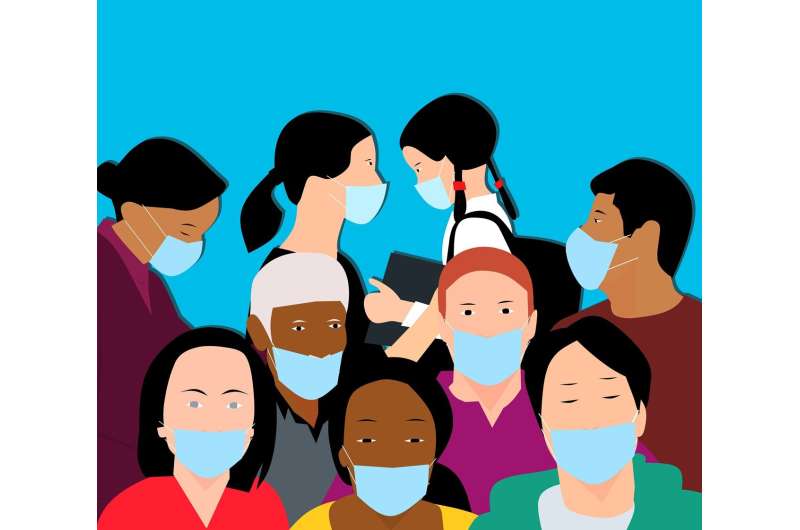This article has been reviewed according to Science X's editorial process and policies. Editors have highlighted the following attributes while ensuring the content's credibility:
fact-checked
peer-reviewed publication
trusted source
proofread
Long COVID cost the Australian economy about $9.6 billion in 2022: Study

Australian workers living with long COVID cost the economy, on average, about $9.6 billion in 2022, according to a new study published in the Medical Journal of Australia.
Led by the University of Melbourne, the Australian National University (ANU) and UNSW Sydney, the researchers calculated the number of lost labor hours of Australian adults who were unable to work, or were forced to work reduced hours, in 2022 because they were experiencing ongoing COVID-19 symptoms up to 12 months after their initial diagnosis.
The researchers say at the height of the COVID-19 pandemic in September 2022, up to 1.3 million Australians were estimated to be living with long COVID. Of these, some 55,000 were children (aged 4 and under) who are ineligible for vaccination in Australia.
ANU Professor Quentin Grafton said the health and economic burden of long COVID in Australia is significant, especially on working adults.
"Workers experiencing ongoing COVID-19 symptoms months after their initial diagnosis resulted in, on average, about 100 million lost labor hours in 2022. This is equivalent to an average loss of eight hours per employed person, per year, including both full-time and part-time employment," Professor Grafton said.
"We estimate this equates to economy-wide losses, on average, of about $9.6 billion in 2022, or one-quarter of Australia's real gross domestic product growth that year. This does not account for losses such as healthy employees who can't work because they're caring for others with long COVID."
University of Melbourne Professor Tom Kompas said the age bracket of Australian workers who are impacting the economy the most is those aged 30 to 49.
"Workers in that age bracket contributed to a loss of 52 million worked hours, or more than 50% of the total labor and productivity lost in 2022," Professor Kompas said.
The researchers looked at the number of COVID-19 infections in Australia from January 2022 to December 2023.
Using data from 5,185 Australian working adults aged 18 and over, the research team developed a mathematical model to calculate the number of people with ongoing COVID-19 symptoms lasting up to three to 12 months, as well as those who never recovered from their illness—people with COVID-19 symptoms lasting longer than 12 months.
The researchers say governments and policymakers in Australia should place a greater emphasis on long COVID as a public health priority.
"A predominant focus of COVID-19 health policy is prevention of hospitalization and death from acute COVID-19, with less attention given to long COVID," UNSW Dr. Valentina Costantino said.
"At the peak of the COVID-19 pandemic in September 2022, between 310,000 and 1.3 million Australians were living with long COVID. We estimate that by December 2024, there are likely to be between 173,000 and 873,000 Australians still living with long COVID 12 months after they were first infected. This does not account for reinfections."
Senior author Professor Raina MacIntyre, also from UNSW, said, "Widespread COVID-19 infection means that even a small percentage of chronic COVID-related illness and disability will impact population health, especially working adults.
"Coronary heart disease affects about three percent of the population and is the leading cause of illness and death in Australia and the world. Long COVID is likely to be up there among the leading causes of burden of disease.
"It's time we considered long COVID in policy decisions, which currently makes it difficult for younger, healthy people to access boosters or antivirals. Widening access will have a better impact on long COVID, as the greatest burden is on working-age adults.
"Other strategies to reduce COVID and thereby long COVID should focus on attention to indoor air quality with improved ventilation."
Researchers said the study also highlights the need to better support people living with long COVID and help them manage their condition.
"We need an enhanced health system capacity to treat long COVID and for social structures to support sufferers and manage their illness. This would improve the quality of life and possibly also the rate at which individuals can return to the workforce," Professor Kompas said.
"Financial assistance for long COVID patients, at least for those unable to work because of their symptoms, such as access to a disability pension, would reduce their economic burden," Professor MacIntyre said.
More information: Valentina Costantino et al, The public health and economic burden of long COVID in Australia, 2022–24: a modelling study, Medical Journal of Australia (2024). DOI: 10.5694/mja2.52400



















